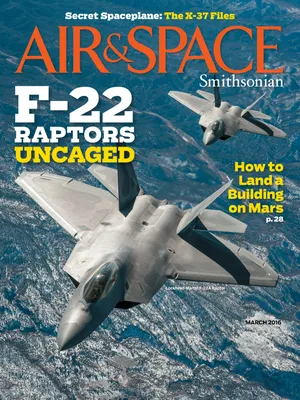The Thunderpiglet and Other Famous Failures
Fail at the drawing board and you fail in the air.
:focal(499x695:500x696)/https://tf-cmsv2-smithsonianmag-media.s3.amazonaws.com/filer/b2/53/b2531503-7ab1-4b9f-bbc0-e1494976dd01/32a_fm2016_hireshwart_live.jpg)
Great successes in aerospace start with calculated risk. So do honorable failures, in which the unknown factors just don’t break the right way. Then there are the projects that start with modest goals or abundant resources and still manage to fail spectacularly.
Consider the Fairchild Republic T-46, designed in the early 1980s to replace the Cessna T-37 Tweet as the U.S. Air Force’s primary trainer. This should not have been hard. Trainers don’t have to set speed, altitude, or range records. Fairchild built a 62-percent-scale proof-of-concept prototype, which convinced many that its approach was low-risk.
The first real T-46 flew in October 1985. Its empty weight was close to the design takeoff weight. Drag was at least 50 percent above predictions. It was able to reach its design maximum speed—but only while in a 40-degree dive.
In the tradition of thunderous Republic nicknames (Thunderbolt, Thunderchief), test crews nicknamed the T-46 “Thunderpiglet.” Then they found that if an engine failed on takeoff, the T-46 would crash unless the landing gear was pulled up the instant the engine quit. From then on, they called it “Eliminator.”
Part of the problem lay in the requirements. The Air Force had demanded less noise, which meant high-bypass-ratio engines. But these were sensitive to disturbed airflow in maneuvering flight, so the designers fitted fat, blunt inlet lips, which caused drag. The customer insisted on side-by-side seating, like the T-37, which gave the airplane a tadpole-like shape and more drag. Months after the first flight, the production program was canceled, and the remaining development effort was terminated a year after that.
Another short, fat, draggy jet was West Germany’s first post-World War II airliner, the VFW 614. The project started in 1961, when many companies dreamed of an airliner that could relieve the thousands of aging DC-3s still hauling passengers and freight worldwide. The 614 had straight wings for short runways. Its trademark feature was a nose and cockpit that were hinged to one side so cargo could be loaded straight on to a truck. Consequently, the floor had to be at truck bed height. Because the designers had chosen a low-set wing, the engines ended up on pylons above the wing.
The 614 first flew in 1971 and entered service in 1975. It was retired in 1981, because it offered propeller-like speeds while guzzling fuel like a jet. I went on a demonstration flight over Alsace in eastern France, sitting in a window seat over the wing. The company spokesman spent most of our journey yelling in my ear, “The production model will be much quieter!” The swing nose that was the root of the problem was eliminated long before any 614s had been built.
Speaking of odd-looking noses: In 1980, I went on a media trip to Woodford airfield near Manchester to view one of the Royal Air Force’s prize projects: the British Aerospace AEW3 Nimrod (a term of abuse only in the U.S., most likely thanks to Bugs Bunny). The Nimrod began as a maritime patrol aircraft; AEW (for “airborne early warning”) missions came later.
Today, you’d look at the AEW3 and see one huge radar attached to its nose and another in its tail. But in 1980 there was only one radar, installed midway along the fuselage and connected by 40-foot-long waveguides to two antennas. Radar engineers are free to scream “Oh NOOOOOO!” at this point, because a lot of things can happen to a signal in a 40-foot waveguide, none of them beneficial.
The radar’s other problems might have been fixable—the main computer, with a staggering 2.4 megabytes of memory, was easily overwhelmed—but there was little to be done about the AEW3’s fundamentally bad design. Those who were involved in the project point to one root cause: When the project was launched—partly to use some spare Nimrod airframes and partly to bolster British tech employment—the radar technology was new and untested.
Three very different aircraft, one lesson: If you start with no clear idea of where you’re going, and you don’t end up somewhere undesirable, what you have been is lucky.
/https://tf-cmsv2-smithsonianmag-media.s3.amazonaws.com/accounts/headshot/32_AM14_BillSweetman_head.jpg)

/https://tf-cmsv2-smithsonianmag-media.s3.amazonaws.com/accounts/headshot/32_AM14_BillSweetman_head.jpg)